Unit 3 At the zoo 表格式单元教案(6个课时)
文档属性
| 名称 | Unit 3 At the zoo 表格式单元教案(6个课时) | 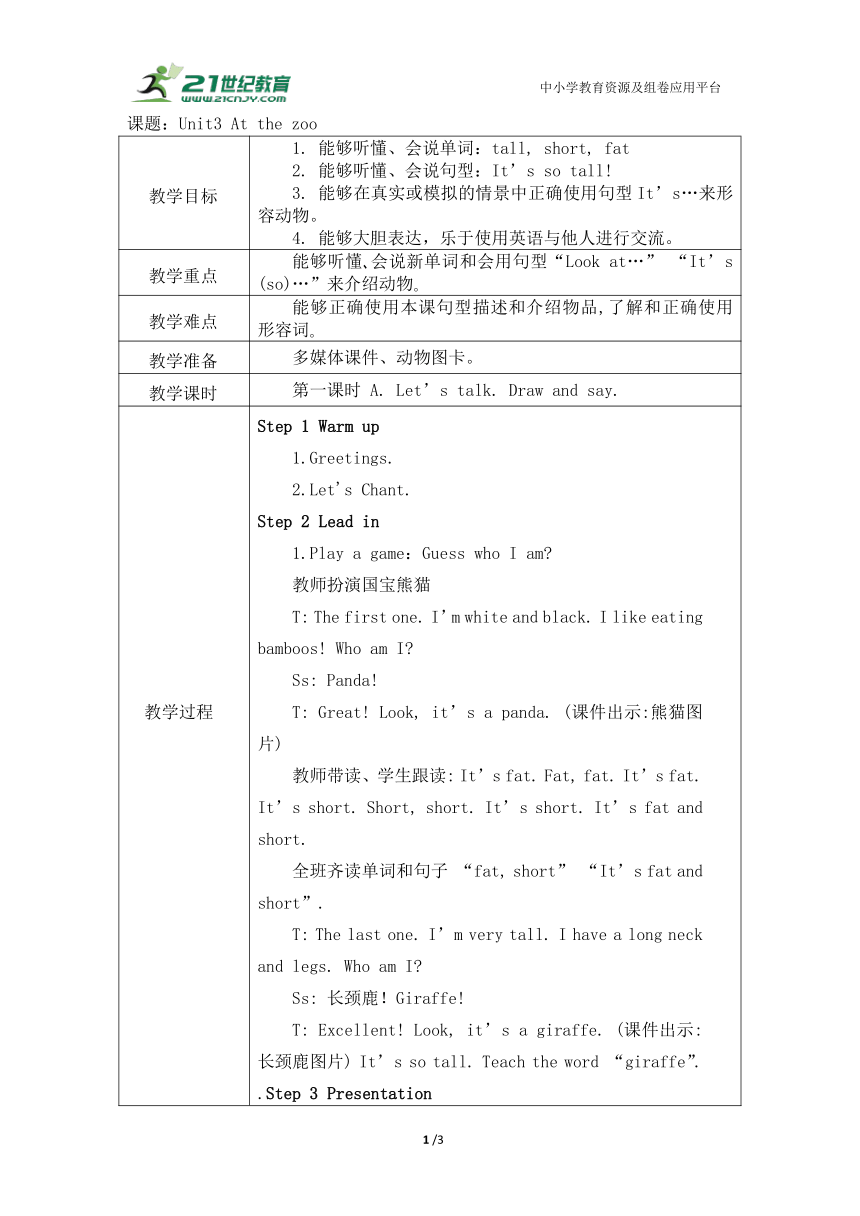 | |
| 格式 | zip | ||
| 文件大小 | 234.0KB | ||
| 资源类型 | 试卷 | ||
| 版本资源 | 人教版(PEP) | ||
| 科目 | 英语 | ||
| 更新时间 | 2023-03-04 17:23:22 | ||
图片预览

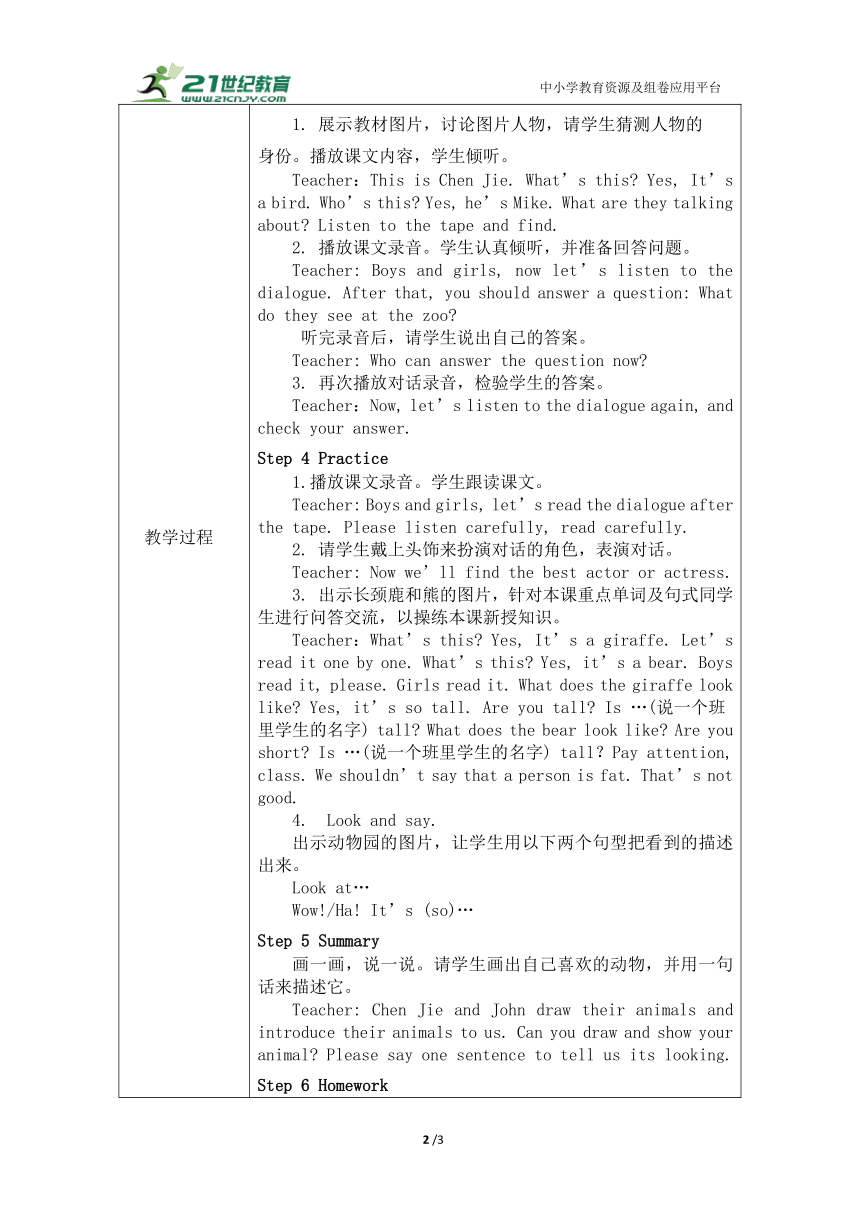
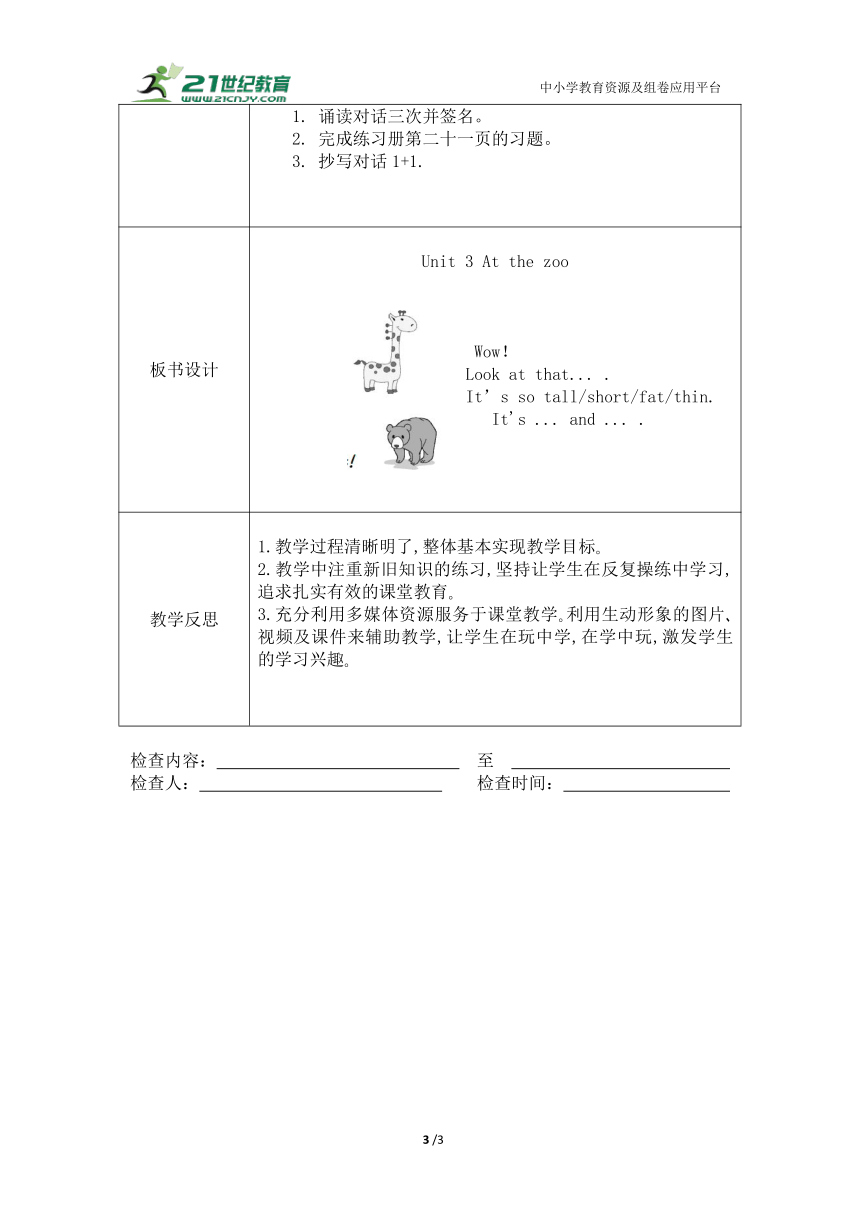
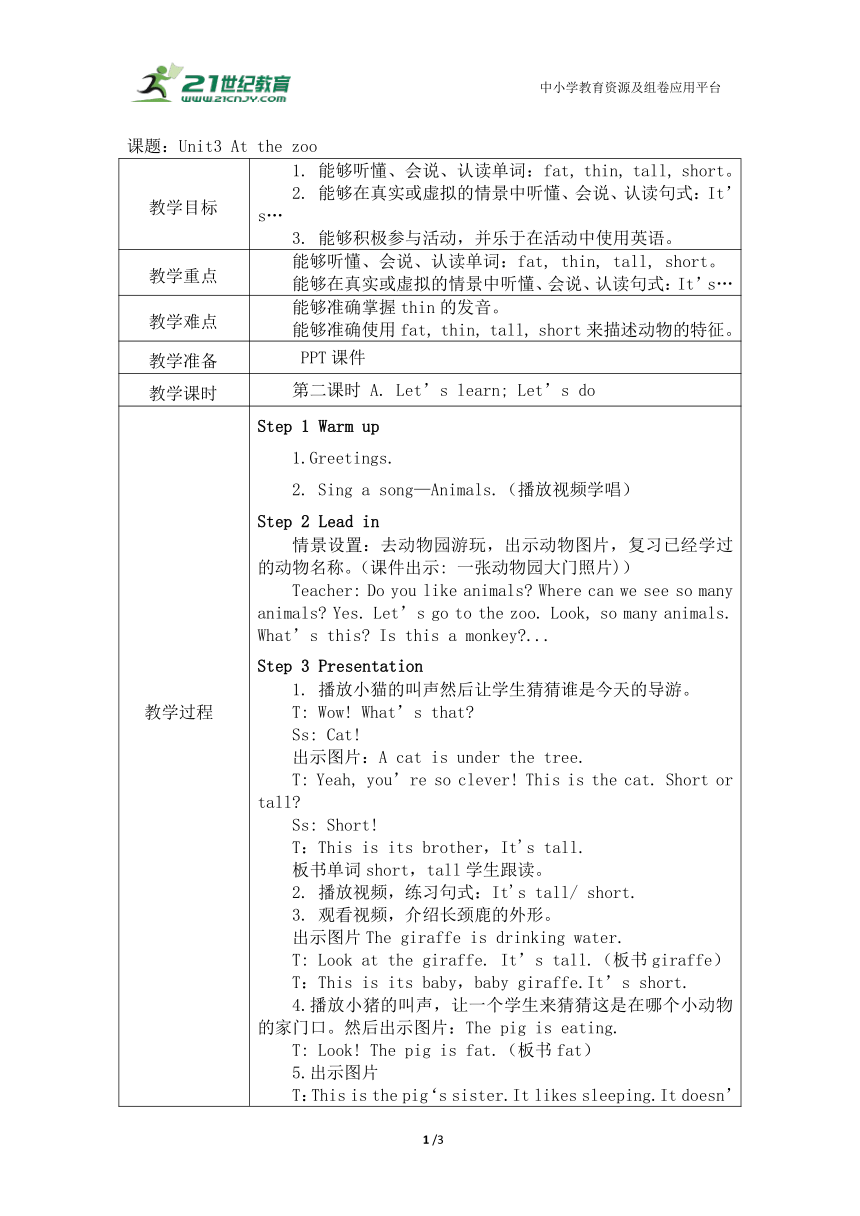
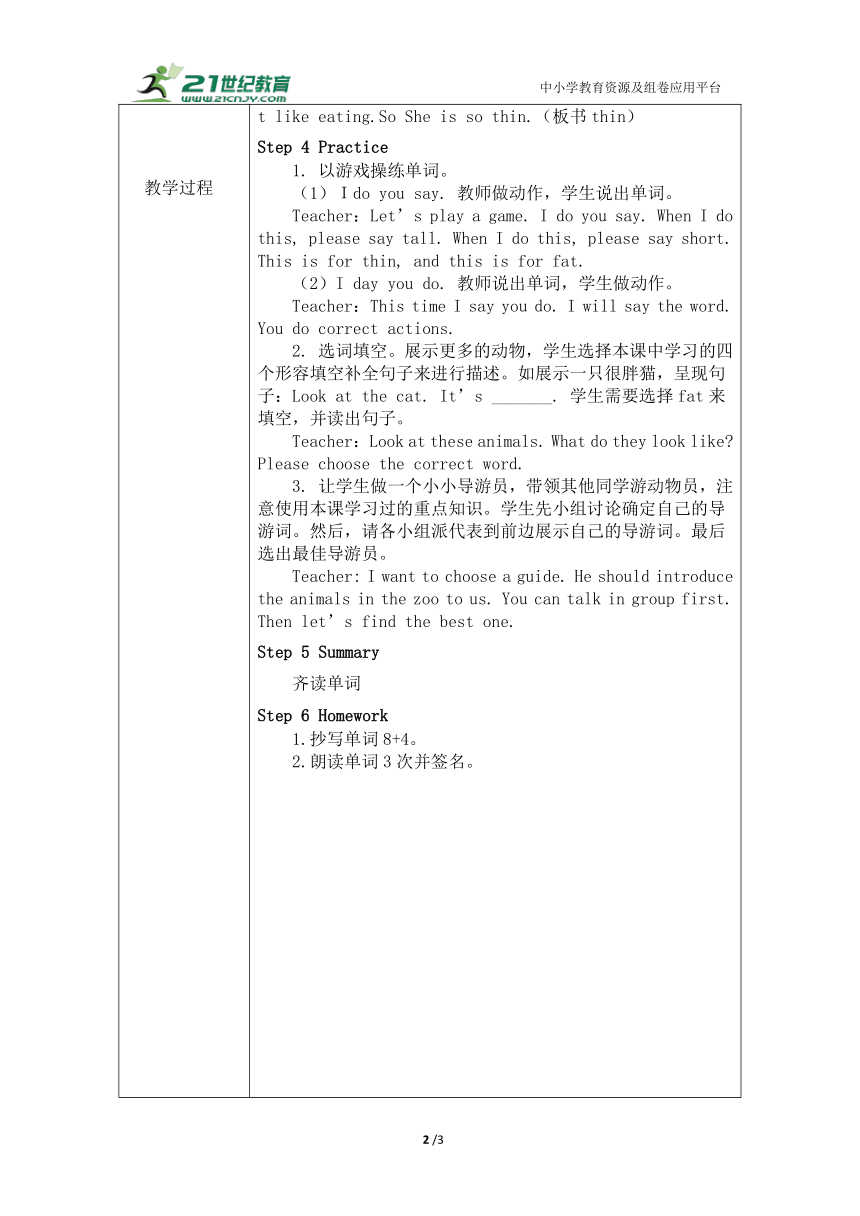
文档简介
课题:Unit3 At the zoo
教学目标 1. 能够听懂、会说单词:tall, short, fat 2. 能够听懂、会说句型:It’s so tall! 3. 能够在真实或模拟的情景中正确使用句型It’s…来形容动物。 4. 能够大胆表达,乐于使用英语与他人进行交流。
教学重点 能够听懂 会说新单词和会用句型“Look at…” “It’s (so)…”来介绍动物
教学难点 能够正确使用本课句型描述和介绍物品,了解和正确使用形容词
教学准备 多媒体课件、动物图卡。
教学课时 第一课时 A. Let’s talk. Draw and say.
教学过程 教学过程 Step 1 Warm up 1.Greetings. 2.Let's Chant. Step 2 Lead in 1.Play a game:Guess who I am 教师扮演国宝熊猫 T: The first one. I’m white and black. I like eating bamboos! Who am I Ss: Panda! T: Great! Look, it’s a panda. (课件出示:熊猫图片) 教师带读、学生跟读: It’s fat. Fat, fat. It’s fat. It’s short. Short, short. It’s short. It’s fat and short. 全班齐读单词和句子 “fat, short” “It’s fat and short”. T: The last one. I’m very tall. I have a long neck and legs. Who am I Ss: 长颈鹿!Giraffe! T: Excellent! Look, it’s a giraffe. (课件出示:长颈鹿图片) It’s so tall. Teach the word “giraffe”. .Step 3 Presentation 1. 展示教材图片,讨论图片人物,请学生猜测人物的身份。播放课文内容,学生倾听。 Teacher:This is Chen Jie. What’s this Yes, It’s a bird. Who’s this Yes, he’s Mike. What are they talking about Listen to the tape and find. 2. 播放课文录音。学生认真倾听,并准备回答问题。 Teacher: Boys and girls, now let’s listen to the dialogue. After that, you should answer a question: What do they see at the zoo 听完录音后,请学生说出自己的答案。 Teacher: Who can answer the question now 3. 再次播放对话录音,检验学生的答案。 Teacher:Now, let’s listen to the dialogue again, and check your answer. Step 4 Practice 1.播放课文录音。学生跟读课文。 Teacher: Boys and girls, let’s read the dialogue after the tape. Please listen carefully, read carefully. 2. 请学生戴上头饰来扮演对话的角色,表演对话。 Teacher: Now we’ll find the best actor or actress. 出示长颈鹿和熊的图片,针对本课重点单词及句式同学生进行问答交流,以操练本课新授知识。 Teacher:What’s this Yes, It’s a giraffe. Let’s read it one by one. What’s this Yes, it’s a bear. Boys read it, please. Girls read it. What does the giraffe look like Yes, it’s so tall. Are you tall Is …(说一个班里学生的名字) tall What does the bear look like Are you short Is …(说一个班里学生的名字) tall?Pay attention, class. We shouldn’t say that a person is fat. That’s not good. Look and say. 出示动物园的图片,让学生用以下两个句型把看到的描述出来。 Look at… Wow!/Ha! It’s (so)… Step 5 Summary 画一画,说一说。请学生画出自己喜欢的动物,并用一句话来描述它。 Teacher: Chen Jie and John draw their animals and introduce their animals to us. Can you draw and show your animal Please say one sentence to tell us its looking. Step 6 Homework 诵读对话三次并签名。 完成练习册第二十一页的习题。 抄写对话1+1.
板书设计 Unit 3 At the zoo Wow! Look at that... . It’s so tall/short/fat/thin. It's ... and ... .
教学反思 1.教学过程清晰明了,整体基本实现教学目标 2.教学中注重新旧知识的练习,坚持让学生在反复操练中学习,追求扎实有效的课堂教育 3.充分利用多媒体资源服务于课堂教学 利用生动形象的图片 视频及课件来辅助教学,让学生在玩中学,在学中玩,激发学生的学习兴趣
检查内容: 至
中小学教育资源及组卷应用平台
检查人: 检查时间:
课题:Unit3 At the zoo
教学目标 1. 能够听懂、会说、认读单词:fat, thin, tall, short。 2. 能够在真实或虚拟的情景中听懂、会说、认读句式:It’s… 3. 能够积极参与活动,并乐于在活动中使用英语。
教学重点 能够听懂、会说、认读单词:fat, thin, tall, short。 能够在真实或虚拟的情景中听懂、会说、认读句式:It’s…
教学难点 能够准确掌握thin的发音。 能够准确使用fat, thin, tall, short来描述动物的特征。
教学准备 PPT课件
教学课时 第二课时 A. Let’s learn; Let’s do
教学过程 教学过程 Step 1 Warm up 1.Greetings. 2. Sing a song—Animals.(播放视频学唱) Step 2 Lead in 情景设置:去动物园游玩,出示动物图片,复习已经学过的动物名称。(课件出示: 一张动物园大门照片)) Teacher: Do you like animals Where can we see so many animals Yes. Let’s go to the zoo. Look, so many animals. What’s this Is this a monkey ... Step 3 Presentation 播放小猫的叫声然后让学生猜猜谁是今天的导游。 T: Wow! What’s that Ss: Cat! 出示图片:A cat is under the tree. T: Yeah, you’re so clever! This is the cat. Short or tall Ss: Short! T:This is its brother,It's tall. 板书单词short,tall学生跟读。 播放视频,练习句式:It's tall/ short. 观看视频,介绍长颈鹿的外形。 出示图片The giraffe is drinking water. T: Look at the giraffe. It’s tall.(板书giraffe) T:This is its baby,baby giraffe.It’s short. 4.播放小猪的叫声,让一个学生来猜猜这是在哪个小动物的家门口。然后出示图片:The pig is eating. T: Look! The pig is fat.(板书fat) 5.出示图片 T:This is the pig‘s sister.It likes sleeping.It doesn’t like eating.So She is so thin.(板书thin) Step 4 Practice 1. 以游戏操练单词。 (1)Ido you say. 教师做动作,学生说出单词。 Teacher:Let’s play a game. I do you say. When I do this, please say tall. When I do this, please say short. This is for thin, and this is for fat. (2)I day you do. 教师说出单词,学生做动作。 Teacher:This time I say you do. I will say the word. You do correct actions. 2. 选词填空。展示更多的动物,学生选择本课中学习的四个形容填空补全句子来进行描述。如展示一只很胖猫,呈现句子:Look at the cat. It’s _______. 学生需要选择fat来填空,并读出句子。 Teacher:Look at these animals. What do they look like Please choose the correct word. 3. 让学生做一个小小导游员,带领其他同学游动物员,注意使用本课学习过的重点知识。学生先小组讨论确定自己的导游词。然后,请各小组派代表到前边展示自己的导游词。最后选出最佳导游员。 Teacher: I want to choose a guide. He should introduce the animals in the zoo to us. You can talk in group first. Then let’s find the best one. Step 5 Summary 齐读单词 Step 6 Homework 1.抄写单词8+4。 2.朗读单词3次并签名。
板书设计 Unit Three At the zoo A. Let’s learn Look at that _________. It’s ___________!
教学反思 1.有效设计开放性的练习,培养学生的发散性思维 2.注重学生学习方法和学习策略的培养 3.充分利用多媒体教学资源,为学生创设真实 自然 贴切的语境,培养学生语言综合应用能力
检查内容: 至
检查人: 检查时间:
课题:Unit3 At the zoo
教学目标 1. 能够听懂、会说、认读、书写单词:big, pig, six, milk。 2. 能够了解元音字母i在单词中发的短音/ /。 3. 能够根据元音字母i的发音规律拼读含有本字母的单词。
教学重点 能够听懂、会说、认读、书写单词:big, pig, six, milk. 能够了解元音字母i在单词中发的短音/ /。
教学难点 能够根据元音字母i的发音规律拼读含有本字母的单词。
教学准备 PPT课件
教学课时 第三课时 Part A. Let’s spell
教学过程 教学过程 Step 1 Warm up 1. TPR活动: Be fat.学生跟着节奏,边说边做动作。 Teacher: First, let’s do some actions. 2. Greetings. Greet with students. 3. Enjoy a song—Letter I. (出示课件) T: Now, let’s sing a song together! Step 2 Lead in Play a guessing game:What's this? 老师与学生同台表演,让学生猜是什么动物。猜对的同学可以获得奖励。游戏的最后一个小动物就是pig,然后出示图片pig。 Step 3 Presentation 通过观察图片,回答问题引出本节课的单词 “big, pig, six, milk”. 板书语音例词,请学生读一读。 T: This is a big pink pig. Now listen carefully , b-i-g, /b/ / / /g/. p-i-n-k /p/ / / / / /k/. T: Can you find the same letter Ss: Yes, they all have letter “i”. T: What is the sound Ss: /Ι/. Let's spell T: Class, look at my mouth. /b/-/Ι/-/g/, big. Follow me, please.(学生跟读) Step 4 Practice 1. 看口型,猜单词。教师说出四个语音例词中的一个,但不出声,学生通过观察老师的口型,猜出单词,并大声读出来。 2. 快速抢读。展示四个单词图卡,学生快速反应,并以拼读的方式读出单词。 3. 播放韵句,学生跟读并表演。 Teacher: I have a chant about the pink pig. Listen carefully. I see a pig. the pig is big. The pig is pink. A big pink pig. I see a pig, A big pink pig. Who can say it quickly Have a try, please. Step 5 Summary 1. Read, listen and circle. (1)学生自己拼读 (2)根据录音把听到的单词圈出来. 2 Look, listen and write. 学生观察图片,然后跟着老师一起拼读单词 (2)学生用今天学到的单词造句。 Step 6 Homework 1.抄写单词8+4。 2.朗读单词8+4。
板书设计 Unit Three At the zoo A. Let’s spell big pig six milk I see a pig. The pig is big. The pig is pink, a big pink pig.
教学反思 1.注重学生学习策略的培养 在学生进行听力练习之前,预留时间请学生对所听内容进行预测和推断,对学生进行有效的听力技巧指导 2.基于单元整体设计创设教学情景,注意话题的延续性和整体性
检查内容: 至
检查人: 检查时间:
课题:Unit3 At the zoo
教学目标 能够听 说 认读单词“big, small, long, short” 通过观察 谈论Let’s talk板块的图片,能够在PPT和教师的帮助下理解对话大意 能够按照正确的语音 语调及意群朗读对话,并在小组中进行角色表演 能够在情景中区分和运用句型“It has a+形容词+单数身体部位.”和“It has+形容词+复数身体部位.”
教学重点 能够听懂、会说、认读句式:It has… 能够理解并能正确认读课文对话,发音准确,语调自然。
教学难点 能够在生活中准确熟练地运用本课时句型进行会话和日常交际
教学准备 PPT课件
教学课时 第四课时 B. Let’s talk; Make a monster
教学过程 教学过程 Step 1 Warm up Enjoy a song:Head shoulders knees and toes. . Ask and answer T:Look at me.What's this? Ss:Nose T:What's this?... Step 2 Lead in Play a game:Touch、Touch(教师来说口令,学生来做动作。例如:Touch your ear.) 最后教师以Touch your tail.引出动物的主题,出示图片让学生猜猜这是谁的尾巴。 Step 3 Presentation 1.出示大象的耳朵、鼻子、尾巴,然后让学生来形容大象的外形 S1:The ears are big. S1: The mouth is big. ... 2. 播放视频,一边思考课件上的问题一边观看视频 T: Look at the children. They are at the zoo. Can you guess What are they talking about Ss: They are talking about the elephant. 2. 再读课文,针对课文内容进行讨论。 T:Who wants to read the text T: What does the elephant have Yes, it has a long nose. It has a short tail. Read after me, please, tail, tail. Does a bird have a tail Does a cow have a tail Does a monkey have a tail Do you have a tail Does the elephant have a tail Is its tail long or short 3. 自由读对话内容,分角色表演课文。 T:Read the dialogue freely. Then I will ask you to act it out. Let’s find the best group. Step 4 Practice 1.展示一个Monster的图像,并介绍,请学生以组为单位设计自己的Monster并介绍。 T: Look, this is a monster. My monster has two big heads, a small body, long hair and a big mouth. Draw your monster and introduce it. You can do it in groups. Then we put our monsters in our classroom. 2. Make your own dialogue. 出示实物:让学生用动物玩偶来写对话。 Step 5 Summary Let's chant I like monsters. What about you It has a long nose, long, long, long. It has a big mouth, big, big, big. It has small ears, small, small, small. It has a short tail, short, short, short. Step 6 Homework 1、练习对话。 2、完成练习册第二十六页的习题。
板书设计
教学反思 1.借助TPR教学法,调动学生的多种感官参与,充分发挥学生的主体作用,激发学生的学习兴趣 2.重视培养学生整体感知内容的能力,树立较强的全局意识 3.教学目标明确,教学重难点把握准确 整个教学过程重点突出,讲练结合,注重实效
检查内容: 至 检查人: 检查时间:
课题:Unit3 At the zoo
教学目标 1. 能够听懂、会说、认读单词small, big, short, long. 2. 能够听懂、会说、认读句式:It has…. 3. 能够积极参与活动,并乐于在活动中用英语进行交流。
教学重点 能够听 说 认读并熟练运用单词“small, big, short, long”和句型“It has…”来描述动物特征
教学难点 能够运用所学形容词和句型在实际情景中恰当地描述动物特征 能够区别使用 “It’s…”和 “It has…”
教学准备 PPT课件
教学课时 第五课时 B. Let’s learn; Let’s do
教学过程 教学过程 Step 1 Warm up 开始课程前,将学生分成四组,在黑板上给每组画一个笑脸。他们表现良好的话,就在每个笑脸的嘴巴画一颗牙次。课程结束时,哪个笑脸的牙齿多哪组获胜。 Sharp eyes Let’s sing—To the zoo.(播放歌曲) Step 2 Lead in 把准备好的怪兽画像发给每个小组。 T: Class,describe it by using the following sentence structures, then make a dialogue: It’s… It has… S1: Look at my monster. S2: Oh, it’s… It has… S1: Yes! S2: Look at my monster. S1: Wow! It’s… It has… Step 3 Presentation 1. 游戏:猜动物。教师或学生来描述一种动物的特征,其他学生来猜出这种动物的名称。最后猜出鸵鸟。 Teacher:Another game for you, guess animals. I will say something about the animal. You try to guess. It has big ears, a long nose and a short tail. What is it Yes, it’s an elephant. Who can try T: It has a small head, a big body, two long legs and a short tail, what is it 2. Let’s learn. (1)观看视频“Let’s learn”. T:What animal is it Let’s listen to the tape and look at the picture. Yes, it’s an ostrich. (课件出示:教材P28 Let’s learn的视频) Step 4 Practice 1. Game 1: I say you do 2. 游戏:谁是记忆大王。出示word map,给学生在2 分钟背单词。 T: What’s the word in the blank 1/2/3/4/5/6 Ss: … Step 5 Summary 1. 展示不同的动物,学生描述其特征。 Teacher:Look at these animals. What do they look like 总结各小组表现 Step 6 Homework 1.抄写单词8+4。 2.完成练习册第二十七页的习题。
板书设计 Unit Three At the zoo B. Let’s learn It has a small head and a short tail.
教学反思 1.注重教学评价,评价语言丰富化和人文化,增强学生自信,激励学生积极参与课堂教学 2.依照学生的年龄特点,创设灵活多样的教学活动,激发学生的学习兴趣和求知欲,让学生在活动中学习知识
检查内容: 至 检查人: 检查时间:
课题:Unit3 At the zoo
教学目标 1. 能够听懂、会说、认读本单元重点单词。 2. 能够听懂故事,并表演。 3. 能够会唱歌曲At the zoo。 4. 能够完成阅读、连线、判断等活动,正确理解、认读本单元重点句式。
教学重点 能够借助图片等帮助描述动物特征
教学难点 能够在实际生活中熟练 合理地运用句型“It’s…” “It has…”来描述身边事物的特征
教学准备 PPT课件
教学课时 第六课时 B. Start to read; Let’s check; Let’s sing. C. Story time
教学过程 Step 1 Warm up Let's do T: Let’s chant together! Be fat. Be fat, fat, fat… Big, big, big, make your eyes big … Step 2 Lead in 出示本单元的所有单词卡片,齐读单词。 2. Guessing game. (出示课件)The teacher reads the riddles and asks: What is it Ss: The mouse!/The panda!/The gold fish!/The dog! T: Great!/Nice!/Good!/Excellent! 3. 猜动物。教师说出动物的特征,请学生猜出动物。 T: Now, let’s guess the animals. It’s black and white. It’s fat. What is it It’s long. It has no legs. What is it It’s thin. It has a long tail. It likes bananas. What is it ... Step 3 Presentation 1. 展示动物图片,简单讲解有关野生动物保护的知识。请学生说一说看到的动物的名称。 Teacher: Look at these animals. Do you know the name of them Please say their name quickly. 2. 播放故事视频,学生认真观察。 T: You know so many animals. What about our friends Zoom and Zip Let’s watch a story about them. Then try to answer: Who knows more animals 3. 学生跟读故事,之后针对课文内容进行交流、讨论: T: This time please read the story. Teacher: How many animals does Zoom know What does he say How many animals do you hear in the story What are they Step 4 Practice 1. Read and match. 2. Choose, say and guess. 3. Listen and tick. 4.Look and match. 5.Text Step 5 Summary 播放歌曲At the zoo,学生跟唱。然后练唱,展示歌曲。 Step 6 Homework 完成练习册第三十一页的习题。 朗读Unit3的所有单词和句子3次并签名。
板书设计 Unit Three At the zoo C. Story time How many animals do you know The small one is a monkey. The big one is a gorilla.
教学反思 1.多种活动的设计,趣味十足,可以很好地激发学生的学习兴趣,调动学生的学习热情,营造积极的学习氛围,吸引学生的注意力 2.突出学生学习的主体地位,教师的教学以引导为主,尽可能给学生足够的时间和空间,让他们自己去理解 学习
检查内容: 至
检查人: 检查时间:
教学目标 1. 能够听懂、会说单词:tall, short, fat 2. 能够听懂、会说句型:It’s so tall! 3. 能够在真实或模拟的情景中正确使用句型It’s…来形容动物。 4. 能够大胆表达,乐于使用英语与他人进行交流。
教学重点 能够听懂 会说新单词和会用句型“Look at…” “It’s (so)…”来介绍动物
教学难点 能够正确使用本课句型描述和介绍物品,了解和正确使用形容词
教学准备 多媒体课件、动物图卡。
教学课时 第一课时 A. Let’s talk. Draw and say.
教学过程 教学过程 Step 1 Warm up 1.Greetings. 2.Let's Chant. Step 2 Lead in 1.Play a game:Guess who I am 教师扮演国宝熊猫 T: The first one. I’m white and black. I like eating bamboos! Who am I Ss: Panda! T: Great! Look, it’s a panda. (课件出示:熊猫图片) 教师带读、学生跟读: It’s fat. Fat, fat. It’s fat. It’s short. Short, short. It’s short. It’s fat and short. 全班齐读单词和句子 “fat, short” “It’s fat and short”. T: The last one. I’m very tall. I have a long neck and legs. Who am I Ss: 长颈鹿!Giraffe! T: Excellent! Look, it’s a giraffe. (课件出示:长颈鹿图片) It’s so tall. Teach the word “giraffe”. .Step 3 Presentation 1. 展示教材图片,讨论图片人物,请学生猜测人物的身份。播放课文内容,学生倾听。 Teacher:This is Chen Jie. What’s this Yes, It’s a bird. Who’s this Yes, he’s Mike. What are they talking about Listen to the tape and find. 2. 播放课文录音。学生认真倾听,并准备回答问题。 Teacher: Boys and girls, now let’s listen to the dialogue. After that, you should answer a question: What do they see at the zoo 听完录音后,请学生说出自己的答案。 Teacher: Who can answer the question now 3. 再次播放对话录音,检验学生的答案。 Teacher:Now, let’s listen to the dialogue again, and check your answer. Step 4 Practice 1.播放课文录音。学生跟读课文。 Teacher: Boys and girls, let’s read the dialogue after the tape. Please listen carefully, read carefully. 2. 请学生戴上头饰来扮演对话的角色,表演对话。 Teacher: Now we’ll find the best actor or actress. 出示长颈鹿和熊的图片,针对本课重点单词及句式同学生进行问答交流,以操练本课新授知识。 Teacher:What’s this Yes, It’s a giraffe. Let’s read it one by one. What’s this Yes, it’s a bear. Boys read it, please. Girls read it. What does the giraffe look like Yes, it’s so tall. Are you tall Is …(说一个班里学生的名字) tall What does the bear look like Are you short Is …(说一个班里学生的名字) tall?Pay attention, class. We shouldn’t say that a person is fat. That’s not good. Look and say. 出示动物园的图片,让学生用以下两个句型把看到的描述出来。 Look at… Wow!/Ha! It’s (so)… Step 5 Summary 画一画,说一说。请学生画出自己喜欢的动物,并用一句话来描述它。 Teacher: Chen Jie and John draw their animals and introduce their animals to us. Can you draw and show your animal Please say one sentence to tell us its looking. Step 6 Homework 诵读对话三次并签名。 完成练习册第二十一页的习题。 抄写对话1+1.
板书设计 Unit 3 At the zoo Wow! Look at that... . It’s so tall/short/fat/thin. It's ... and ... .
教学反思 1.教学过程清晰明了,整体基本实现教学目标 2.教学中注重新旧知识的练习,坚持让学生在反复操练中学习,追求扎实有效的课堂教育 3.充分利用多媒体资源服务于课堂教学 利用生动形象的图片 视频及课件来辅助教学,让学生在玩中学,在学中玩,激发学生的学习兴趣
检查内容: 至
中小学教育资源及组卷应用平台
检查人: 检查时间:
课题:Unit3 At the zoo
教学目标 1. 能够听懂、会说、认读单词:fat, thin, tall, short。 2. 能够在真实或虚拟的情景中听懂、会说、认读句式:It’s… 3. 能够积极参与活动,并乐于在活动中使用英语。
教学重点 能够听懂、会说、认读单词:fat, thin, tall, short。 能够在真实或虚拟的情景中听懂、会说、认读句式:It’s…
教学难点 能够准确掌握thin的发音。 能够准确使用fat, thin, tall, short来描述动物的特征。
教学准备 PPT课件
教学课时 第二课时 A. Let’s learn; Let’s do
教学过程 教学过程 Step 1 Warm up 1.Greetings. 2. Sing a song—Animals.(播放视频学唱) Step 2 Lead in 情景设置:去动物园游玩,出示动物图片,复习已经学过的动物名称。(课件出示: 一张动物园大门照片)) Teacher: Do you like animals Where can we see so many animals Yes. Let’s go to the zoo. Look, so many animals. What’s this Is this a monkey ... Step 3 Presentation 播放小猫的叫声然后让学生猜猜谁是今天的导游。 T: Wow! What’s that Ss: Cat! 出示图片:A cat is under the tree. T: Yeah, you’re so clever! This is the cat. Short or tall Ss: Short! T:This is its brother,It's tall. 板书单词short,tall学生跟读。 播放视频,练习句式:It's tall/ short. 观看视频,介绍长颈鹿的外形。 出示图片The giraffe is drinking water. T: Look at the giraffe. It’s tall.(板书giraffe) T:This is its baby,baby giraffe.It’s short. 4.播放小猪的叫声,让一个学生来猜猜这是在哪个小动物的家门口。然后出示图片:The pig is eating. T: Look! The pig is fat.(板书fat) 5.出示图片 T:This is the pig‘s sister.It likes sleeping.It doesn’t like eating.So She is so thin.(板书thin) Step 4 Practice 1. 以游戏操练单词。 (1)Ido you say. 教师做动作,学生说出单词。 Teacher:Let’s play a game. I do you say. When I do this, please say tall. When I do this, please say short. This is for thin, and this is for fat. (2)I day you do. 教师说出单词,学生做动作。 Teacher:This time I say you do. I will say the word. You do correct actions. 2. 选词填空。展示更多的动物,学生选择本课中学习的四个形容填空补全句子来进行描述。如展示一只很胖猫,呈现句子:Look at the cat. It’s _______. 学生需要选择fat来填空,并读出句子。 Teacher:Look at these animals. What do they look like Please choose the correct word. 3. 让学生做一个小小导游员,带领其他同学游动物员,注意使用本课学习过的重点知识。学生先小组讨论确定自己的导游词。然后,请各小组派代表到前边展示自己的导游词。最后选出最佳导游员。 Teacher: I want to choose a guide. He should introduce the animals in the zoo to us. You can talk in group first. Then let’s find the best one. Step 5 Summary 齐读单词 Step 6 Homework 1.抄写单词8+4。 2.朗读单词3次并签名。
板书设计 Unit Three At the zoo A. Let’s learn Look at that _________. It’s ___________!
教学反思 1.有效设计开放性的练习,培养学生的发散性思维 2.注重学生学习方法和学习策略的培养 3.充分利用多媒体教学资源,为学生创设真实 自然 贴切的语境,培养学生语言综合应用能力
检查内容: 至
检查人: 检查时间:
课题:Unit3 At the zoo
教学目标 1. 能够听懂、会说、认读、书写单词:big, pig, six, milk。 2. 能够了解元音字母i在单词中发的短音/ /。 3. 能够根据元音字母i的发音规律拼读含有本字母的单词。
教学重点 能够听懂、会说、认读、书写单词:big, pig, six, milk. 能够了解元音字母i在单词中发的短音/ /。
教学难点 能够根据元音字母i的发音规律拼读含有本字母的单词。
教学准备 PPT课件
教学课时 第三课时 Part A. Let’s spell
教学过程 教学过程 Step 1 Warm up 1. TPR活动: Be fat.学生跟着节奏,边说边做动作。 Teacher: First, let’s do some actions. 2. Greetings. Greet with students. 3. Enjoy a song—Letter I. (出示课件) T: Now, let’s sing a song together! Step 2 Lead in Play a guessing game:What's this? 老师与学生同台表演,让学生猜是什么动物。猜对的同学可以获得奖励。游戏的最后一个小动物就是pig,然后出示图片pig。 Step 3 Presentation 通过观察图片,回答问题引出本节课的单词 “big, pig, six, milk”. 板书语音例词,请学生读一读。 T: This is a big pink pig. Now listen carefully , b-i-g, /b/ / / /g/. p-i-n-k /p/ / / / / /k/. T: Can you find the same letter Ss: Yes, they all have letter “i”. T: What is the sound Ss: /Ι/. Let's spell T: Class, look at my mouth. /b/-/Ι/-/g/, big. Follow me, please.(学生跟读) Step 4 Practice 1. 看口型,猜单词。教师说出四个语音例词中的一个,但不出声,学生通过观察老师的口型,猜出单词,并大声读出来。 2. 快速抢读。展示四个单词图卡,学生快速反应,并以拼读的方式读出单词。 3. 播放韵句,学生跟读并表演。 Teacher: I have a chant about the pink pig. Listen carefully. I see a pig. the pig is big. The pig is pink. A big pink pig. I see a pig, A big pink pig. Who can say it quickly Have a try, please. Step 5 Summary 1. Read, listen and circle. (1)学生自己拼读 (2)根据录音把听到的单词圈出来. 2 Look, listen and write. 学生观察图片,然后跟着老师一起拼读单词 (2)学生用今天学到的单词造句。 Step 6 Homework 1.抄写单词8+4。 2.朗读单词8+4。
板书设计 Unit Three At the zoo A. Let’s spell big pig six milk I see a pig. The pig is big. The pig is pink, a big pink pig.
教学反思 1.注重学生学习策略的培养 在学生进行听力练习之前,预留时间请学生对所听内容进行预测和推断,对学生进行有效的听力技巧指导 2.基于单元整体设计创设教学情景,注意话题的延续性和整体性
检查内容: 至
检查人: 检查时间:
课题:Unit3 At the zoo
教学目标 能够听 说 认读单词“big, small, long, short” 通过观察 谈论Let’s talk板块的图片,能够在PPT和教师的帮助下理解对话大意 能够按照正确的语音 语调及意群朗读对话,并在小组中进行角色表演 能够在情景中区分和运用句型“It has a+形容词+单数身体部位.”和“It has+形容词+复数身体部位.”
教学重点 能够听懂、会说、认读句式:It has… 能够理解并能正确认读课文对话,发音准确,语调自然。
教学难点 能够在生活中准确熟练地运用本课时句型进行会话和日常交际
教学准备 PPT课件
教学课时 第四课时 B. Let’s talk; Make a monster
教学过程 教学过程 Step 1 Warm up Enjoy a song:Head shoulders knees and toes. . Ask and answer T:Look at me.What's this? Ss:Nose T:What's this?... Step 2 Lead in Play a game:Touch、Touch(教师来说口令,学生来做动作。例如:Touch your ear.) 最后教师以Touch your tail.引出动物的主题,出示图片让学生猜猜这是谁的尾巴。 Step 3 Presentation 1.出示大象的耳朵、鼻子、尾巴,然后让学生来形容大象的外形 S1:The ears are big. S1: The mouth is big. ... 2. 播放视频,一边思考课件上的问题一边观看视频 T: Look at the children. They are at the zoo. Can you guess What are they talking about Ss: They are talking about the elephant. 2. 再读课文,针对课文内容进行讨论。 T:Who wants to read the text T: What does the elephant have Yes, it has a long nose. It has a short tail. Read after me, please, tail, tail. Does a bird have a tail Does a cow have a tail Does a monkey have a tail Do you have a tail Does the elephant have a tail Is its tail long or short 3. 自由读对话内容,分角色表演课文。 T:Read the dialogue freely. Then I will ask you to act it out. Let’s find the best group. Step 4 Practice 1.展示一个Monster的图像,并介绍,请学生以组为单位设计自己的Monster并介绍。 T: Look, this is a monster. My monster has two big heads, a small body, long hair and a big mouth. Draw your monster and introduce it. You can do it in groups. Then we put our monsters in our classroom. 2. Make your own dialogue. 出示实物:让学生用动物玩偶来写对话。 Step 5 Summary Let's chant I like monsters. What about you It has a long nose, long, long, long. It has a big mouth, big, big, big. It has small ears, small, small, small. It has a short tail, short, short, short. Step 6 Homework 1、练习对话。 2、完成练习册第二十六页的习题。
板书设计
教学反思 1.借助TPR教学法,调动学生的多种感官参与,充分发挥学生的主体作用,激发学生的学习兴趣 2.重视培养学生整体感知内容的能力,树立较强的全局意识 3.教学目标明确,教学重难点把握准确 整个教学过程重点突出,讲练结合,注重实效
检查内容: 至 检查人: 检查时间:
课题:Unit3 At the zoo
教学目标 1. 能够听懂、会说、认读单词small, big, short, long. 2. 能够听懂、会说、认读句式:It has…. 3. 能够积极参与活动,并乐于在活动中用英语进行交流。
教学重点 能够听 说 认读并熟练运用单词“small, big, short, long”和句型“It has…”来描述动物特征
教学难点 能够运用所学形容词和句型在实际情景中恰当地描述动物特征 能够区别使用 “It’s…”和 “It has…”
教学准备 PPT课件
教学课时 第五课时 B. Let’s learn; Let’s do
教学过程 教学过程 Step 1 Warm up 开始课程前,将学生分成四组,在黑板上给每组画一个笑脸。他们表现良好的话,就在每个笑脸的嘴巴画一颗牙次。课程结束时,哪个笑脸的牙齿多哪组获胜。 Sharp eyes Let’s sing—To the zoo.(播放歌曲) Step 2 Lead in 把准备好的怪兽画像发给每个小组。 T: Class,describe it by using the following sentence structures, then make a dialogue: It’s… It has… S1: Look at my monster. S2: Oh, it’s… It has… S1: Yes! S2: Look at my monster. S1: Wow! It’s… It has… Step 3 Presentation 1. 游戏:猜动物。教师或学生来描述一种动物的特征,其他学生来猜出这种动物的名称。最后猜出鸵鸟。 Teacher:Another game for you, guess animals. I will say something about the animal. You try to guess. It has big ears, a long nose and a short tail. What is it Yes, it’s an elephant. Who can try T: It has a small head, a big body, two long legs and a short tail, what is it 2. Let’s learn. (1)观看视频“Let’s learn”. T:What animal is it Let’s listen to the tape and look at the picture. Yes, it’s an ostrich. (课件出示:教材P28 Let’s learn的视频) Step 4 Practice 1. Game 1: I say you do 2. 游戏:谁是记忆大王。出示word map,给学生在2 分钟背单词。 T: What’s the word in the blank 1/2/3/4/5/6 Ss: … Step 5 Summary 1. 展示不同的动物,学生描述其特征。 Teacher:Look at these animals. What do they look like 总结各小组表现 Step 6 Homework 1.抄写单词8+4。 2.完成练习册第二十七页的习题。
板书设计 Unit Three At the zoo B. Let’s learn It has a small head and a short tail.
教学反思 1.注重教学评价,评价语言丰富化和人文化,增强学生自信,激励学生积极参与课堂教学 2.依照学生的年龄特点,创设灵活多样的教学活动,激发学生的学习兴趣和求知欲,让学生在活动中学习知识
检查内容: 至 检查人: 检查时间:
课题:Unit3 At the zoo
教学目标 1. 能够听懂、会说、认读本单元重点单词。 2. 能够听懂故事,并表演。 3. 能够会唱歌曲At the zoo。 4. 能够完成阅读、连线、判断等活动,正确理解、认读本单元重点句式。
教学重点 能够借助图片等帮助描述动物特征
教学难点 能够在实际生活中熟练 合理地运用句型“It’s…” “It has…”来描述身边事物的特征
教学准备 PPT课件
教学课时 第六课时 B. Start to read; Let’s check; Let’s sing. C. Story time
教学过程 Step 1 Warm up Let's do T: Let’s chant together! Be fat. Be fat, fat, fat… Big, big, big, make your eyes big … Step 2 Lead in 出示本单元的所有单词卡片,齐读单词。 2. Guessing game. (出示课件)The teacher reads the riddles and asks: What is it Ss: The mouse!/The panda!/The gold fish!/The dog! T: Great!/Nice!/Good!/Excellent! 3. 猜动物。教师说出动物的特征,请学生猜出动物。 T: Now, let’s guess the animals. It’s black and white. It’s fat. What is it It’s long. It has no legs. What is it It’s thin. It has a long tail. It likes bananas. What is it ... Step 3 Presentation 1. 展示动物图片,简单讲解有关野生动物保护的知识。请学生说一说看到的动物的名称。 Teacher: Look at these animals. Do you know the name of them Please say their name quickly. 2. 播放故事视频,学生认真观察。 T: You know so many animals. What about our friends Zoom and Zip Let’s watch a story about them. Then try to answer: Who knows more animals 3. 学生跟读故事,之后针对课文内容进行交流、讨论: T: This time please read the story. Teacher: How many animals does Zoom know What does he say How many animals do you hear in the story What are they Step 4 Practice 1. Read and match. 2. Choose, say and guess. 3. Listen and tick. 4.Look and match. 5.Text Step 5 Summary 播放歌曲At the zoo,学生跟唱。然后练唱,展示歌曲。 Step 6 Homework 完成练习册第三十一页的习题。 朗读Unit3的所有单词和句子3次并签名。
板书设计 Unit Three At the zoo C. Story time How many animals do you know The small one is a monkey. The big one is a gorilla.
教学反思 1.多种活动的设计,趣味十足,可以很好地激发学生的学习兴趣,调动学生的学习热情,营造积极的学习氛围,吸引学生的注意力 2.突出学生学习的主体地位,教师的教学以引导为主,尽可能给学生足够的时间和空间,让他们自己去理解 学习
检查内容: 至
检查人: 检查时间:
